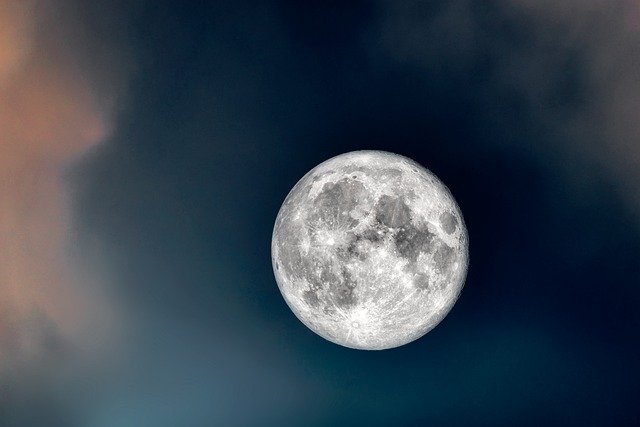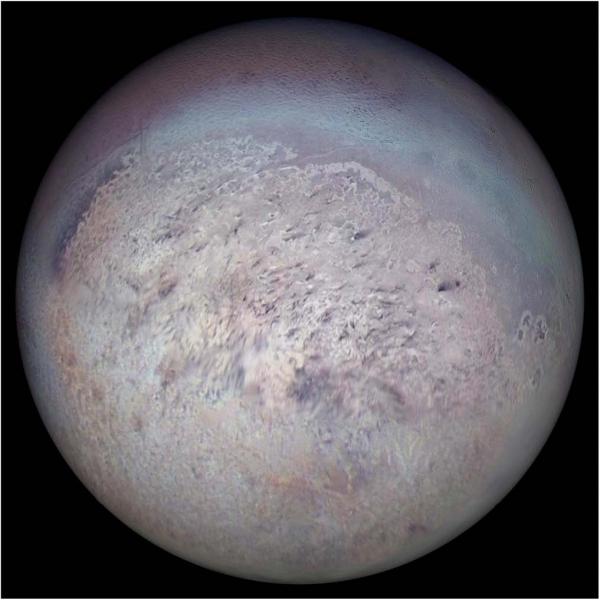*This post may contain affiliate links. This means we may make a commission if you purchase an item using one of our links*
The main differences between the Moon and Triton is that the Moon orbits Earth whilst Triton orbits Neptune, Neptune orbits in a retrograde motion whilst the Moon in the normal counterclockwise motion and the Moon is bigger with a diameter of 3,474.8km whilst Triton’s diameter is 2,706km.
There are various other differences between the two so, continue reading for a more detailed look at both entities along with their similarities and differences below.
What Is The Moon?
Table of Contents

The moon is the gray celestial being that orbits our Earth. It is also tidally locked to Earth meaning that we only see one side of it at any time in our sky.
It takes the moon roughly 27 days to complete an orbit around Earth, which it does in an elliptical pattern. The Moon’s axial tilt is very straight at 1.5 degrees. As a result of the tidally locked status along with the effects that Earth has on its general rotational patterns, it takes the Moon roughly 29.5 days to complete a day.
In regards to its temperature, it fluctuates where it can be really hot at 127 degrees Celsius when the Sun is shining on it and to -173 degrees in areas where the Sun does not strike it. It’s core on the other hand is far hotter ranging between 1,327 to 1,427 degrees Celsius.
This is as a result of the lunar entity’s extremely thin to practically non-existent atmosphere, which not only results in these massive temperature shifts but, is also the reason why it has over 100,000 craters on its surface.
Speaking of the Moon’s surface, the entity is mostly made of rocks, iron, magnesium just like most of the other moons and terrestrial based planets in our solar system.
It is among the bigger moons in our solar system with a diameter of 3,474.8km and a mass of 7.35 × 10^22 kg, which actually places it fifth amongst all moons in our solar system and would also make it bigger than the dwarf planet Pluto.
Despite all the advancements in technology, the last time a manned mission was made to the Moon was on the Apollo 17 way back in December 1972 and no further missions have been done since, possibly as result of the political agendas behind the numerous countries vying for opportunities that we don’t know of.
What Is The Moon Triton?

Triton is the largest moon orbiting Neptune, whose most unusual feature is its retrograde orbit. Triton is the only major moon in our solar system which orbits in the opposite direction of its planet’s rotation.
First discovered on 10th October 1846 (just 17 days after the discovery of its planet, Neptune) by British astronomer William Lassell, “Triton” comes from a merman in Greek myth; a name which perhaps stems from the composition of this faraway moon.
The diameter of Triton is approximately 2,706km, making it a similar size to Earth’s moon. However, we know that its mass is far less than the first estimates suggested because data from Voyager showed that the surface is icy and highly reflective, a less dense composition than the dark surface of our moon.
This icy surface has resulted in ice based natural satellite displaying temperatures in the region of – 235 degrees Celsius.
This lower density stems predominantly from the water-ice interior encasing a denser rock core. Still, the mean density of 2.06 grams per cubic cm remains higher than that of any of Saturn’s or Uranus’ moons. In addition, Triton holds more than 99.5% of the mass of everything that orbits the planet Neptune and its total mass is greater than every smaller satellite in the solar system combined.
Scientists think that Triton may be an object from the Kuiper Belt that Neptune’s gravity captured millions of years ago. This is because it shares many similarities with the dwarf planet Pluto – the best-known world within the Kuiper Belt.
This frozen world is a land of geological oddities with craters and a collection of depressions and ridges known as cantaloupe terrain. The geysers found on this moon shoot plumes of nitrogen as high as 8km high, which creates a thin atmosphere of nitrogen.
In around 3.5 billion years, Triton’s orbit will travel too close to Neptune, and the planet’s gravitational pull will break the moon apart, creating a ring system.
Similarities Between The Moon And Triton
As both are natural satellites, the Moon and Triton do share a few similarities, which includes the following:
- Both have a hotter central core.
- Both have a rocky, terrestrial surface.
- Both are spherical in shape.
- Neither have rings surrounding them.
- Both are tidally locked to their planet.
- Both orbit their planet in an elliptical pattern.
- Neither have a magnetic field.
- Neither have tectonic plates.
Differences Between The Moon And Triton
In regards to the differences that the two show, they include the below:
- The Moon is the bigger of the two with a diameter of 3,474.8km whilst Triton has a diameter of 2,706km.
- Triton orbits Neptune whilst the Moon orbits Earth.
- Triton has a very thin exosphere composed mostly of nitrogen with small amounts of methane whilst the Moon’s atmosphere is thin composed of helium, neon, argon and hydrogen.
- A day on Triton takes 5.877 days whilst a the Moon day is 28 days.
- It takes Triton 5.877 days to orbit Neptune whilst the Moon orbits Earth in 29.5 days.
- The Moon orbits Earth at an average distance of 384,400km whilst Triton is 354,800 km from Neptune.
- Triton’s average temperature is around -235 degrees Celsius whilst the Moon’s temperature can be a very hot 127 to a chilling -173 degrees Celsius.
- Triton is volcanically active whilst the moon isn’t.
- The Moon’s density is 3.34 g/cm³ whilst Triton’s density is 2.06 g/cm³.
- The Moon’s mass is 7.35 × 10^22 kg whilst Triton’s mass is 2.14 × 10^22 kg.
- Triton’s gravitational strength is 0.779 m/s² whilst the Moon’s is 1.62 m/s².
- Triton is the only moon in our solar system that orbits its planet in a retrograde orbit.
Summary
As both the Moon and Triton are natural satellites, it makes sense that both entities would share common features such as a thin atmosphere, terrestrial, rocky surface and the fact both orbit another object.
Nevertheless, their differences in size, mass, length of day, the orbital motion and more which is what makes both natural satellites very distinct and ultimately function uniquely from one another.

